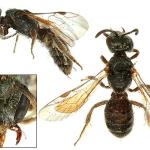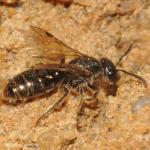A southern species which can sometimes be locally frequent. It is found from Cornwall to Kent and north to Lincolnshire and the West Midlands. It occurs in south Wales but not in Ireland or Scotland. Also found in the Channel Islands: Alderney, Guernsey and Jersey.
This is a Western Palaearctic species, found from the Azores and the Canary Isles, eastwards through north Africa, to Asia Minor and the Levant, and north as far as southern Sweden (S P M Roberts, pers. comm.).
This species is not regarded as scarce or threatened.
A species of warm, sandy places, such as banks, quarries, outcrops and coastal sands. Rarely found on calcareous grassland.
The female flies from mid March to October and the male from mid June until late September.
Probably usually a solitary mining bee, occasionally nesting in aggregations. The nest is dug in sandy soil, and consists of a vertical main burrow from which several lateral tunnels branch off, each terminating in one cell. There may be two to eight cells in a nest; each one is constructed, provisioned, an egg laid and then sealed before the next one is constructed. It is possible that the female digs another burrow when the first is complete.
Visits to flowers of a number of plant families are recorded, including Asteraceae and Rosaceae, but also Lamiaceae, Apiaceae, Ranunculaceae, Caryophyllaceae, Euphorbiaceae, Primulaceae and Scrophulariaceae.
The bee Sphecodes longulus von Hagens is a recorded cleptoparasite of Lasioglossum minutissimum.
2019



